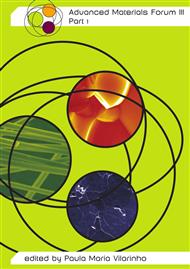p.1323
p.1328
p.1333
p.1338
p.1343
p.1348
p.1353
p.1358
p.1363
Effect of Deposition and Processing Conditions for LaNiO3 Bottom Electrodes on the Properties of Pb(Zr,Ti)O3 Thin Film Capacitors Made by RF Magnetron Sputtering
Abstract:
Three types of bottom electrodes were deposited by RF magnetron sputtering on SiO2/Si substrates: LaNiO3 (LNO), Pt/Ti and LNO/Pt/Ti. The effect of different deposition and processing conditions for the LNO films on the ferroelectric properties of sputtered Pb(Zr0.52Ti0.48)O3 (PZT) capacitors was investigated. The LNO films were either deposited at room temperature and heattreated in O2 flow in the furnace at 500 or 600°C or made in situ in the range of 200-500°C. Other deposition parameters under study were the pressure, the RF power and the Ar:O2 ratio. The resistivity of the LNO films was measured and on some of the films with the lower values, amorphous PZT was deposited and then crystallized in the furnace. X-ray diffraction results show that the PZT films deposited over Pt/Ti had a preferential (100) orientation, while those deposited over LNO made in situ are strongly (100) oriented and the ones deposited over amorphous LNO do not exhibit any preferential orientation. The remanent polarization of the capacitors was around 28μC/cm2 when amorphous LNO or Pt/Ti electrodes were used and around 20μC/cm2 with LNO made in situ. Leakage currents were improved when LNO electrodes made in situ was used; a good ferroelectric fatigue performance of the capacitors when subjected to 1010 switching cycles was also observed
Info:
Periodical:
Pages:
1343-1347
Citation:
Online since:
May 2006
Authors:
Keywords:
Price:
Сopyright:
© 2006 Trans Tech Publications Ltd. All Rights Reserved
Share:
Citation:


